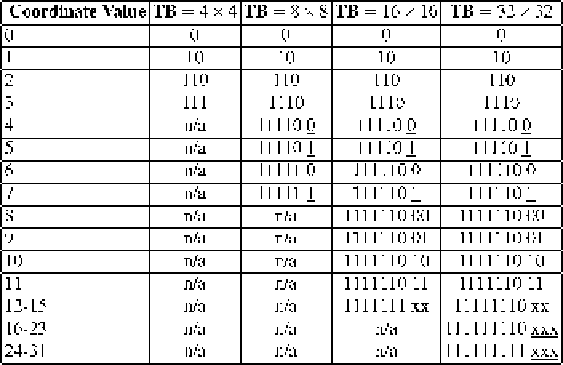Graphics Reference
In-Depth Information
Tabl e 8. 9
Binarization of coordinate values of the last position
Bins belonging to the bypass coded suffixes are underlined
8.6.4.2
Last Position Coding
As mentioned earlier, there are strong data dependencies between
significant
_coeff_flag
(SIG) and
last_significant_coeff_flag
(LAST) in
H.264/AVC due to the fact that they are interleaved. Budagavi and Demircin
[
10
] proposed grouping several SIG together by transmitting a LAST only once
per N number of SIG. If all of the N SIG are zero, LAST is not transmitted.
Sole et al. [
73
] avoids interleaving of SIG and LAST altogether. Specifically, the
horizontal (x) and vertical (y) position of the last non-zero SIG in a TB is sent in
advance rather than LAST by using the syntax elements
last_sig_coeff_x
and
last_sig_coeff_y
, respectively. For instance, in the example shown in
Fig.
8.9
,
last_sig_coeff_x
equal to 3 and
last_sig_coeff_y
equal to 0
are sent before processing the TB rather than signaling LAST for each SIG with
value of 1. Signaling the (x, y) position of the last non-zero SIG for each TB was
adopted into HM3.0. Note that the SIG in the last scan position is inferred to be 1.
The last position, given by its coordinates in both x and y direction, is composed
of a prefix and suffix as shown in Table
8.9
. The prefixes
last_sig_coeff
_x_prefix
and
last_sig_coeff_y_prefix
are both regular coded using
TrU binarization with cMax
D
2
.log
2
TrafoSize/
1 [
70
]. A suffix is present
when the corresponding prefix is composed of more than four bins. In that case, the
suffixes
last_sig_coeff_x_suffix
and
last_sig_coeff_y_suffix
are bypass coded using FL binarization. Some of the contexts are shared across the
chroma TB sizes to reduce context memory, as shown in Table
8.10
. To maximize
the impact of fast bypass coding, the bypass coded bins (i.e., the suffix bins) for
both the x and y coordinate of the last position are grouped together for each TB in
HEVC.

